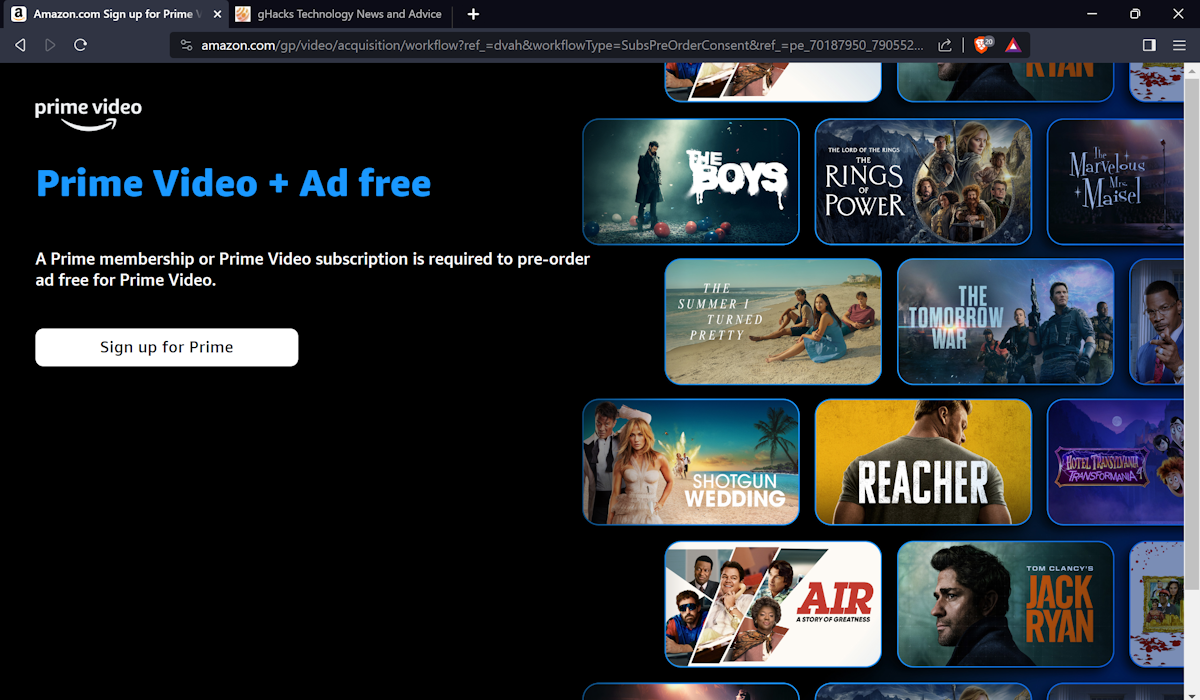How to switch to a different regional Store in the Amazon App

Amazon operates regional stores that customers may buy products from. The Stores are not limited to customers from a specific region, but some products may not be purchasable if a customer comes from a different region. There are ways around that, for instance, by using proxy services, but many items are available.

In 2009 I explained how consumers can benefit from a global economy, and it is still possible.
Using multiple Amazon stores is useful especially when there are not any added taxes when you make purchases; this is the case when you live in the European Union, as you can make purchases on Amazon Germany, France or Spain, to name a few, without having to pay customs tax for the purchased items. Note that you may have to pay extra for shipping, even as a Prime customer, when you make purchases in a different regional Amazon store.
It is easy enough to switch between different Amazon Stores using a web browser. Just point the browser to the store, e.g. amazon.de for the German store, amazon.fr for the French Store, or Amazon.es for the Spanish store, and you can start to browse it and make purchases using your Amazon account. The app makes it more difficult, as there is no direct option to open another regional store with just a click or entering of a different address.
The following guide walks you through the steps of switching to different regional stores in the Amazon application.
Switching Amazon Stores in the app

Open the Amazon Shopping application on your device to get started. It should look similar to what you see on the screenshot above. Activate the menu (three horizontal bars) in the lower right corner of the interface to open the main menu.
Scroll down on the page until you get to the Settings section. Amazon displays Store sections at the top, but when you scroll down, you will reach the Settings. Tap on Settings to expand the menu.

The Country & Language preference shows the flag of the country of the selected Amazon Store. Activate the preference with a tap to open the region and language switcher. Amazon displays the active country/region, the language that is used, and the currency on the page.
If you switched to another region in the past in the app, you will see it listed below the defaults for quick switching.

Tap on the region to display all available regions that you may switch to. The application displays all Stores, but separates them into Stores that support the current language and Stores that do not.
The first group lists all Stores that support the selected language, the second group all Stores that do not.

Select another region with a tap. If the selected region supports the language, it is set automatically. If the language is not supported for the selected regional store, you are asked to select one of the supported languages instead.

Select the "done" button to switch to the region, language and currency that is displayed. Note that "done" is displayed in the language that will be set.
Amazon's app reloads at this point and loads the new Store based on the settings.

You may change the Store region and language at any time by repeating the steps described above.
Now You: do you use online Stores to make purchases? Did you buy products from Stores in different regions?



















This was helpful, thank you!
Yes, I buy from multiple Amazon sites. I used to have 4 different accounts at 4 different Amazon sites. With different user names and passwords, of course.
At some point, Amazon forced me to use the same user name and password for all those accounts. I did not even understand how it happened. There was no warning of the type : it seems you’re the same person, please change your identifiers accordingly. I can’t even explain how they forced me to do it. Probably the identifiers stopped working at some point, and they forced me into a recovery procedure, at the end of which all identifiers were miraculously identical. I found this considerably annoying.
On the other hand, there is now automatic translation on some of those sites, which is very convenient.
For anything remotely technical (computers, home appliances, tools…) I recommend German users’s reviews. They are incredibly thorough and precise, to the point of being fastidious. If there’s something remotely wrong in a product whith electronics or a motor inside, a German buyer will point it out. It seems everybody is an engineer out there. You don’t need to buy on the German site, of course.
To me this article looks like an Amazon ad. Indeed, Owl, the labour conditions and treatment of employees at Amazon are heartbreaking, humiliating and simply shocking. Thinking individuals don’t purchase from Amazon. But sheeple and consumption addicts don’t think.
Don’t worry, those workers will soon be replaced with robots. They won’t have any jobs at all. Maximum profits. Maximum efficiency. Maximum stock value. Build back better.
The reality of living in the EU or the US is that you live in a capitalist system regardless of your socio-politico-economic system preference. If you are a card-carrying capitalist, you find nothing wrong with putting mom and pop shops out of business. Survival of the fittest. Reward for initiative and risk. Creative destruction and all that. If you are a Marxist you do everything you can to hasten the demise of advanced capitalism. That means turning the petit bourgeoisie against the bigger capitalists. Hastening the demise of mom and pop shops effectively returns them to the proletariat. With these justifications, whether capitalist or Marxist, you can feel great about continuing to buy crappy crap from Amazon.
Worst thing with Amazon is after sometime they launch their own products and that’s where it all gets messy.
> Worst thing with Amazon is after sometime they launch their own products and that’s where it all gets messy.
That hits the nail on the head!
The essence of the distribution industry is to defeat rivals and survive.
In other words, it is a “market monopoly.
Amazon’s corporate strategy is to analyze consumer needs based on purchase performance and search data, and then create private brands (PB) based on those needs to weed out national brands (NB).
So, in the actual online store display, “PB takes precedence” and NB is hard to find. The product you really want will never show up unless you search with a specific and accurate product name.
Amazon’s PB’s may appear to be a good value at a low price, but the quality is inferior.
For Amazon to monopolize the market is for the culture to collapse.
By the time they realize it, it will be too late, and the cruel reality will be that “a wilderness (the cityscape has been devastated and turned into a ghost town) has spread all around.
Dependence on Amazon should be in moderation.
And your evidence for lower quality is?
Amazon can easily buy in quantity that matches or exceeds the quality for a lower price.
@DrKnow,
NB is not necessarily superior.
PB is not necessarily inferior.
However, “long-established businesses” and “craftsmen” are special because they do not betray the trust of their customers.
Now, for those of you who have a “deny the unknown” nature, let me try to explain it in terms that even a child can understand.
From milk, cream, butter, and can be cheese borne. That said, milk as it is not a substitute for them. Cheeses can also be varied, such as Camembert, Roquefort, Mimolette, and Gouda.
In short, even if the ingredients and recipe are identical, the technology, environment, and know-how can create something unique.
Grapes can be eaten as they are, but they can also be made into raisins, jams and juices, wine and cognac.
From the Merlot grape, the best quality Romanée-Comté is produced from cheap wines made by négociants. The resulting wines vary widely depending on the vineyard, harvest method, vinification method, vintage, and winemaker.
If people lacking such insight are involved, they can only produce a poor substitute.
Take “tools”, for example.
PB (Switzerland) for screwdrivers, Snap-on (US) and KTC (Japan) for wrenches, BAHCO (Sweden) for monkey wrenches, and Knipex (Germany) for nippers and pliers are exceptional. You will know what you are getting when you use them.
Quality is relative to the user’s expectations.
If users had no such standards, Amazon’s PB would get a passing grade.
The biggest problem is that if Amazon were to weed out NB, such “special products” and “technology” would die out.
Text correction:
Before,
From the Merlot grape, the best quality Romanée-Comté is produced from cheap wines made by négociants.
After,
From the Merlot grape, a stark difference arises from the inexpensive wines produced by négociants to the highest quality Romanée-Comté. Romanée-Comté can only be produced in that special place.
About the wine case study,
Burgundy (Bourgogne, France) was used as a case study, but the grape variety is not “Merlot” but “Pinot Noir”.
Incidentally, the famous “Beaujolais” produced in a corner of Burgundy is an AOC for the Gamay grape variety.
In German wine, the white wines of the Rheingau and Mosel regions, which are produced from the Riesling grape, are excellent; they are divided into quality categories from “Tafelwein” to “Prädikatswein” and subdivided into “Kabinett” to “Beerenauslese” and others.
Thus, strict “Quality Control” is defined by culture (food culture).
Owl Googling trying to look knowledgeable as usual without a concise answer and even less relevant than normal.
When people answer like that, you just know that they have no real rebuttal evidence about what they’ve been questioned. Just waffle to try and obfuscate.
Hint – the majority of people will NEVER buy Snap-on etc. Amazon isn’t aiming for that market. I know it’s a hard grasp for you.
@DrKnow,
Your “non-diversity” is remarkable!
I am commenting on an example of my real life experience, which you, with your poor imagination, cannot imagine.
Did you not see my opening comments, links to quotes, etc.?
To reply, etc., on such a matter would be wrong in itself!
From the Ancestors, our family have been regular patrons of their favorite restaurants and department stores, and wine is an essential part of their meals. I have interacted with chefs, pastry chefs, and sommeliers, gaining knowledge and experience. And from my professional life, I am also familiar with the “business community”.
Our family loves to drink, and we even have a wine cave (wine cellar) at home to host our regular home parties.
And I own several motorbikes, sports cars, and road bikes, which I maintain myself whenever possible.
I do my own maintenance on my audio equipment and home, and I use the tools in the case study as those tools.
Your biggest problem is that you are completely unwilling to understand the values and circumstances of anyone other than yourself.
So you will never post a comment that is “in the public interest”, you will simply be a “troll”.
And you should at least change your handle to one that is appropriate for you.
For example, “Dr green hand”
@Owl
You have me interested now. I too love wine and I’d really like to see a photo of your extensive wine cellar.
Perhaps you can share?
@DrKnow,
Well, I guess it’s your lowly fact-check,
Let’s pretend that you “love wine too” and (as a like-minded person) show it “just a bit”.
https://i.imgur.com/6B7Jxh2.jpeg
https://i.imgur.com/fViVNUW.jpeg
All collections are purchased by the case at the time of initial release, using reefer containers, and with thorough distribution control from shipping to receiving (so-called traceability).
In their collections, wine (French, Italian, American, Chilean, Australian, German, and others) and Champagne are the main items, but cognac, scotch, vintage port, noble rot, tequila, and Shaoxing wine are also regular items.
The wine rack uses Super Erector shelves (W1821 x D460) and is tailored with 6 tiers (P1590), effectively 7 tiers if the bottom space at the bottom is included (By alternating the bottles, 150%+ the amount is stored).
This is “as far as” I am going to publish on the Internet.
So, I’ll leave it at that.
It’s my original, wine bottles are wrapped in two or three layers of PE wrap with wrinkles. This is to protect the bottles from unforeseen vibrations such as earthquakes, etc. By adhering closely to each other, the bottles are prevented from falling and have a tremendous shock-absorbing effect.
What makes those tools special is not only that they are the most comfortable to use, but that they stick to the parts, handle it reliably, and “never damage the parts”.
With cheap tools, the parts are damaged, and the tools are deformed.
Cheap ones are not only not cost-effective, but are a totally useless substitute.
It is not “expensive” because you can’t afford it (or don’t feel like buying it).
So, “price” is determined by the nature of the product for a good reason (simplified as “raw materials, costs, and profit margins,” but both raw materials and costs fluctuate in proportion to quality).
In general, the price of NB products is reasonable.
Inexpensive products are inferior products made with poor quality raw materials, labor and property costs that are far from reality (poor workshops, low wages by hiring low-capacity personnel, etc.).
That is Amazon’s PB.
‘Match or exceeds the quality at lower price’
I suppose you don’t know the basics of economics. You see, a monopoly always tries to destroy the competition and then raise the price due to no resistance by the rest of the industry. One example – Amazon Prime subscription which has been increasing every year because they can without any resistance. There are other examples but then you can find them yourself. All you need to do is break your little bubble you don’t know you’re in one right now and then you’ll see.
@yash
I was questioning owl’s comment regarding lower quality.
Nice of you to reply about something I never said.
@Gerard,
> Thinking individuals don’t purchase from Amazon.
Indeed, I used to be “determined” to do so as well.
I even admonished my relatives and friends to avoid Amazon.
A few months ago, a rare item that was not available after working with department stores and vendors, but was available on “Amazon”, was the catalyst for my change of heart.
However, I feel that the things I get from online shopping are just “objects” and do not generate “affection”.
Even with “objects”, the process of getting them will give rise to affection, attachment, and become a commemorative “treasure”. I feel that the richness of life is such “memories”.
So, I have cold feelings about online shopping.
You are nominated for the Soviet Worker of the Week award.
By all rights, as much as possible I want to shop by the act of “seeing, touching, and checking” the actual product.
Shopping is fun because the very act of going out there is an act of “going out” (I get fresh impressions from nature, encounters, and other once-in-a-lifetime experiences).
Even without shopping, just window shopping is fun.
Our family loved to go to such department stores etc., spend time in museums and parks, and enjoy eating and drinking in cafés and restaurants.
However, online shopping is useful for “limited wants,” repeat purchases such as consumables, items that are not available in my immediate area, or when I am unable to go out.
I also use “Amazon” from time to time.
And I have purchased from Amazon stores in Germany, the US, and the UK. It is convenient for me as a consumer, but the labor conditions (low wages, overwork) at Amazon that I have learn by hearsay about are heartbreaking.